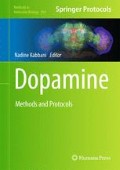Abstract
The ability of certain neurotransmitter receptors to form oligomers provides an additional level of fine-tuning of intracellular signaling. Among the techniques allowing study of receptor oligomerization as well as influence of specific ligands on these processes, a biophysical approach with the use of fluorescently tagged receptors is the most sensitive. Measurement of the fluorescence resonance energy transfer (FRET) phenomenon between two fluorescently tagged receptors is considered a very useful and measurable tool to study the physical interactions between receptors either in a single cell or in a population of living cells. Here we describe the use of FRET measurement specifically to monitor protein oligomer formation between dopamine D1R and D2R, but the same methodology can be used to study other receptor proteins as well as their mutants.
Access this chapter
Tax calculation will be finalised at checkout
Purchases are for personal use only
References
Hansen JL, Sheikh SP (2004) Functional consequences of 7TM receptor dimerization. Eur J Pharm Sci 23:301–317
Prinster SC, Hague C, Hall RA (2005) Heterodimerization of G protein-coupled receptors: specificity and functional significance. Pharmacol Rev 57:289–298
Aizman O, Brismar H, Uhlén P, Zettergren E, Levey AI, Forssberg H, Greengard P, Aperia A (2000) Anatomical and physiological evidence for D1 and D2 dopamine receptor colocalization in neostriatal neurons. Nat Neurosci 3:226–230
Hasbi A, Fan T, Alijaniaram M, Nguyen T, Perreault ML, O’Dowd BF, George SR (2009) Calcium signaling cascade links dopamine D1-D2 receptor heteromer to striatal BDNF production and neuronal growth. Proc Natl Acad Sci U S A 106:21377–21382
Dziedzicka-Wasylewska M, Faron-Górecka A, Andrecka J, Polit A, Kuśmider M, Wasylewski Z (2006) Fluorescence studies reveal heterodimerization of dopamine D1 and D2 receptors in the plasma membrane. Biochemistry 45:8751–8759
Janetopoulos C, Devreotes P (2002) Monitoring receptor-mediated activation of heterotrimeric G-proteins by fluorescence resonance energy transfer. Methods 27:366–373
Elangovan M, Day RN, Periasamy A (2002) Nanosecond fluorescence resonance energy transfer-fluorescence lifetime imaging microscopy to localize the protein interactions in a single living cell. J Microsc 205:3–14
Lakowicz JR (1999) Principles of fluorescence spectroscopy. Kluwer Academic/Plenum Publishers, New York
Sambrook J, Fritsch EF, Maniatis T (1996) Molecular cloning: a laboratory manual. Cold Spring Harbor Laboratory Press, New York
Faron-Górecka A, Górecki A, Kuśmider M, Wasylewski Z, Dziedzicka-Wasylewska M (2008) The role of D1-D2 receptor hetero-dimerization in the mechanism of action of clozapine. Eur Neuropsychopharmacol 18:682–691
Stanasila L, Perez JB, Vogel H, Coteechia S (2003) Oligomerization of the alpha 1a- and alpha 1b-adrenergic receptor subtypes. Potential implications in receptor internalization. J Biol Chem 278:40239–40251
Acknowledgments
The authors would like to dedicate this work to the memory of the late professor Zygmunt Wasylewski, who encouraged us to employ fluorescence spectroscopy in our studies of dopamine receptors.
Author information
Authors and Affiliations
Corresponding author
Editor information
Editors and Affiliations
Rights and permissions
Copyright information
© 2013 Springer Science+Business Media, LLC
About this protocol
Cite this protocol
Lukasiewicz, S., Faron-Górecka, A., Dziedzicka-Wasylewska, M. (2013). A Biophysical Approach for the Study of Dopamine Receptor Oligomerization. In: Kabbani, N. (eds) Dopamine. Methods in Molecular Biology, vol 964. Humana Press, Totowa, NJ. https://doi.org/10.1007/978-1-62703-251-3_6
Download citation
DOI: https://doi.org/10.1007/978-1-62703-251-3_6
Published:
Publisher Name: Humana Press, Totowa, NJ
Print ISBN: 978-1-62703-250-6
Online ISBN: 978-1-62703-251-3
eBook Packages: Springer Protocols

